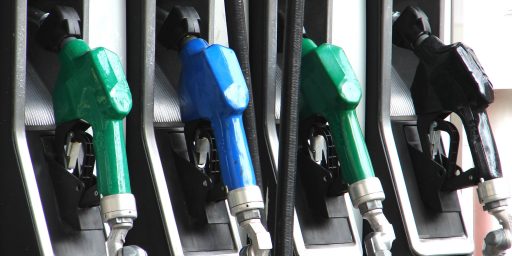Gas Prices About Average
Jeff Jacoby, only a couple months behind OTB, points out in today’s Boston Globe that gasoline prices aren’t high by historic standards.
Comparing today’s prices with those of yesteryear is a meaningless exercise unless the prices are given in constant, or “real,” dollars. And in real dollars, gas prices today are — well, normal.
Sure, the $2.03 being charged at the pump today seems high. But in actual financial terms, it’s a lot less onerous than the $1.25 a gallon motorists were paying in 1980 — a whopping $2.80 when translated into 2004 dollars. (Adjusted the other way, today’s $2.03 pump price is equal to 89 cents in 1980 dollars.) When it comes to historical price comparisons, nominal dollar amounts signify little. It is the inflation-adjusted price that tells you whether the true cost of a product has increased, decreased, or stayed the same.
There’s also the question of affordability. Adjusted for inflation, gasoline prices today are roughly where they were in the 1950s — but per-capita real income then was no more than half of what it is today. Which means that for a typical driver 50 years ago, gasoline was really twice as expensive, in terms of the bite it took out of his budget, as it is now. Only in the shallow sense of nominal pump price is gasoline today “setting record after record.” In reality, it is much cheaper than it used to be.
That is especially true over the very long term. In his 2000 book “It’s Getting Better All The Time,” economist Stephen Moore noted that while US energy prices fluctuate all the time, the trend for the past century has been toward ever-greater affordability. Adjusted for wage growth, the price of oil was about five times cheaper than in 1900, Moore wrote, and roughly the same as it was in 1950 — and that was true notwithstanding the vast amount of oil and gasoline that Americans have consumed. How can gas and oil be getting more affordable when we consume so much? The secret, Moore says, is innovation and technology:
“Before the 1950s it was almost unthinkable that oil could be drilled and extracted from the bottom of the sea. In 1965, one of the first offshore oil rigs drilled oil from 600 feet deep off the coast of California. By the late 1980s, the record for offshore oil drilling reached 10,000 feet. It has been precisely this kind of innovation that has confounded the doomsayers who in the 1960s and 1970s predicted global oil shortages and even depletion.”
Ironically, it’s the fact that gas prices have been relatively low that slows down innovation, since it’s not worth the capital investment to find alternative sources of energy when gas is so affordable.




Yup. I had been thinking about posting along these lines, but it’s nice to see the actual figures.
One thing that’s bothered me about Moore’s line of thinking in that book is that he believes that there will always be a supply to fill the demand. Problem is that with China coming into the fore the demand is now outstripping supply, outside of some areas in the Russian -stans we’ve run out of potential new fields to explore, and we’re running out of tricks to improve production on marginal wells and fields. His thinking is pervasive in the conservative community, and it’s worrying.
I do agree with you — increased prices will mean an increased incentive to find alternative sources of energy. They will also mean increased incentives to conserve petroleum and improve efficency in gas-powered systems. In the long-term, alternative energy sources are the solution, but improving efficency will help us in the short run.